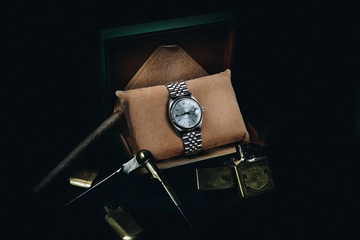Proper Cleaning and Maintenance
Regular cleaning and maintenance are key to preserving the beauty and functionality of your Kloira watch. Gently clean your watch with a soft cloth to remove dirt and oils, and avoid exposing it to harsh chemicals. For a deeper clean, consult a professional service to ensure that every component, including the delicate watch mechanism, remains in optimal condition. Regular maintenance checks can prevent potential issues and keep your timepiece performing flawlessly.

Cleaning Non-Water Resistant Watches
Use a Soft Cloth:
Gently wipe the watch with a dry, soft cloth to remove dust and oils. Avoid using any cleaning solutions or water.
Avoid Moisture:
Do not expose the watch to any moisture or liquids, as this can damage the internal mechanisms and materials.
Dust Removal:
Attachments on the case that allow for a strap or bracelet to be connected to the watch case.
Professional Cleaning:
For deeper cleaning or if you’re unsure about cleaning methods, consult a professional to avoid any potential damage.
Essential Watch Care Tips




Essential Watch Care Tips
Ensure the crown is securely screwed in before exposure to water. Even water-resistant watches should be kept dry to protect internal components.
Handle your watch gently to avoid drops and impacts. Be cautious when engaging in activities that could expose it to physical stress.
Regularly check and maintain your watch strap. Replace or repair worn straps to ensure a secure fit and enhance overall comfort.
Replace the battery promptly when it runs low to avoid potential damage. Have the replacement done by a professional to ensure proper handling.

Professional Servicing and Repairs
Even with diligent care at home, your Kloira watch may require professional attention to ensure its continued precision and performance. Over time, regular wear can affect the accuracy and functionality of your timepiece, and certain components may experience wear and tear that only a trained eye can detect.
Professional servicing involves a thorough inspection of all internal and external parts, from the intricate mechanisms driving the movement to the condition of the case and bracelet. Expert technicians will clean and lubricate the movement, replace any worn-out parts, and perform detailed testing to ensure your watch is operating at its best. This meticulous process not only restores the watch’s functionality but also preserves its aesthetic appeal.
Entrusting your Kloira watch to skilled professionals for regular servicing guarantees that it remains in perfect working order, allowing it to maintain its luxurious appearance and dependable performance for years to come. By following recommended service intervals, you’re investing in the longevity of your timepiece, ensuring it continues to be a cherished part of your collection.
More Guide
Frequently Ask Question
What are the different movements in watches?
Watches typically feature three main types of movements: manual, automatic, and quartz. Manual movements require daily winding and are known for their traditional craftsmanship. Automatic movements self-wind through the wearer’s wrist motion, offering convenience without daily winding. Quartz movements, powered by a battery, provide superior accuracy and require minimal maintenance. Additionally, hybrid movements like kinetic and solar combine mechanical and quartz elements for enhanced functionality.
Which movement is best for watch?
The best movement depends on personal preferences. Manual movements are ideal for traditionalists who enjoy daily winding. Automatic movements offer convenience through self-winding. Quartz movements are perfect for those who prioritize accuracy and low maintenance. Each type has its advantages, and the choice depends on whether you value heritage, convenience, or precision in your timepiece.
Why are automatic watches popular?
Automatic watches are celebrated for their blend of traditional craftsmanship and convenience. They offer precision timekeeping without requiring daily winding, making them a preferred choice for many enthusiasts.
Which type of motion is watch?
Watches utilize either mechanical or electronic motion. Mechanical watches, including manual and automatic, operate through gears and springs. Quartz watches use electronic motion, powered by a battery and a quartz crystal. Mechanical movements create a consistent ticking motion, while quartz movements offer high accuracy through precise vibrations.
How to choose a watch movement?
Choosing a watch movement involves considering your lifestyle and preferences. Manual movements suit those who appreciate traditional craftsmanship. Automatic movements are convenient, self-winding through wrist motion. Quartz movements prioritize accuracy and low maintenance. Consider factors like budget and desired features to select the best movement for your needs.
Which watch movement is most accurate?
Quartz movements are the most accurate, powered by a battery and a vibrating quartz crystal. They lose or gain only a few seconds per month. In contrast, mechanical movements, including manual and automatic, have variations of several seconds per day. Quartz watches are preferred for their superior accuracy.
What movement do luxury watches use?
Luxury watches predominantly use mechanical movements, including manual and automatic, due to their intricate craftsmanship. High-end brands often develop in-house movements, ensuring exclusivity and superior quality. While quartz movements are less common, some luxury brands offer high-end quartz models for unparalleled accuracy.
Which is better, quartz or automatic watch?
The choice between quartz and automatic watches depends on preferences. Quartz watches are highly accurate, low-maintenance, and affordable, requiring only periodic battery changes. Automatic watches are cherished for their craftsmanship and heritage, self-winding through wrist motion. Choose quartz for precision and convenience, automatic for traditional mechanical appeal.
Which watch movement is more expensive?
Mechanical movements, including manual and automatic, are generally more expensive than quartz movements due to intricate craftsmanship and complex engineering. Brands that develop in-house movements command premium prices. Quartz movements are simpler and cheaper to produce, making quartz watches more affordable, though high-end quartz models can be expensive.
How to tell if a watch is automatic?
To identify an automatic watch, observe the second hand’s smooth, sweeping motion, unlike the ticking motion of quartz watches. Check if the watch self-winds with wrist motion. Many automatic watches have a transparent case back to view the movement. Listen for a continuous ticking sound, different from quartz watches’ distinct ticks.




























